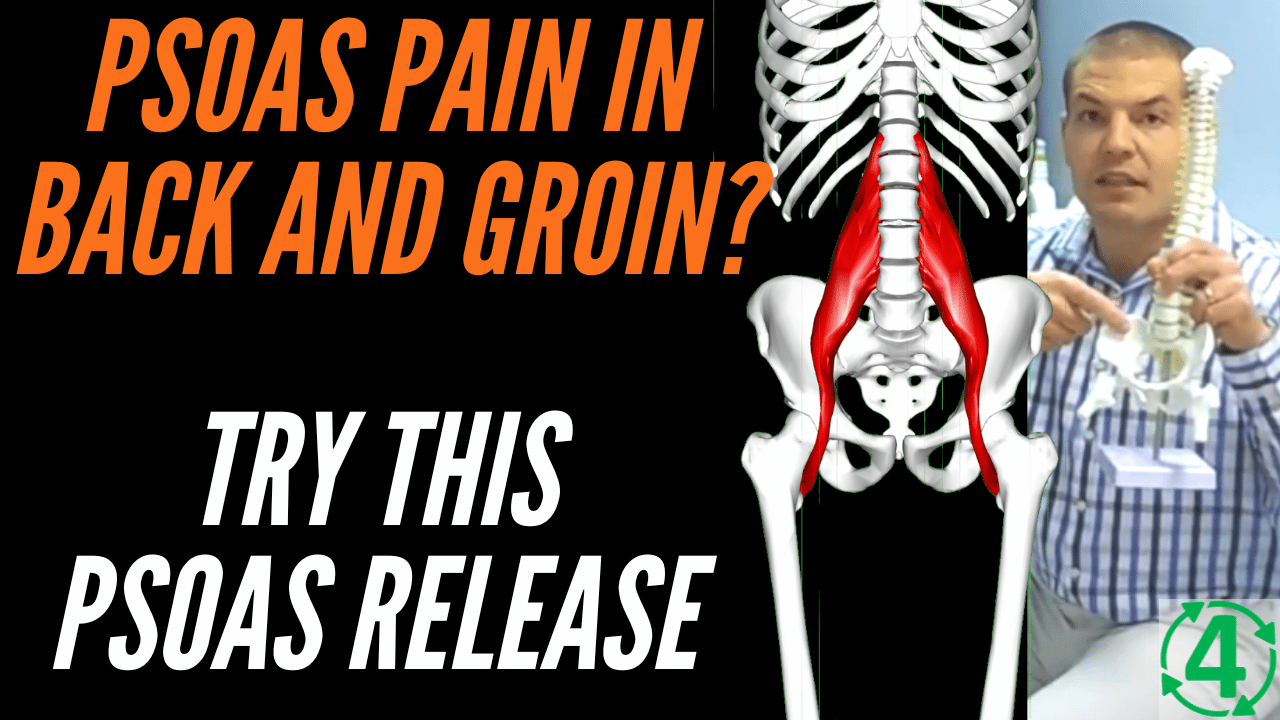How Do You Relieve Psoas Pain In Your Back And Groin?
Watch the video to learn a simple psoas release technique to relieve back and groin pain.

A psoas joke from a real patient of mine:
To be fair, it was from a group of Kenyan runners with whom his daughter used to train.
She was asking them if they knew about the psoas muscle and they replied:
Yeah, we know all about the psoas... When it's tight that's exactly what you get: a so' ass.
Crude but true, a stiff psoas can cause pain in the back, pain in the groin, pain in the butt, or sciatica.
But the questions remains as to how the psoas gets tight in the first place.
Where Are The Psoas Muscles?
The "P-soas" What?
The word "psoas" comes from the Greek word psoa meaning "muscles of the loins".
And that describes exactly where the psoas is.
The psoas muscle originates from the front of your lumbar (lower back) vertebrae and attaches to your thigh bone (femur).
That makes the psoas muscle a hip flexor, meaning it helps you lift your leg such as when getting into a car, getting in bed, or climbing stairs.
As you can see in the picture, the psoas is part of the iliopsoas, which is made up of 2 parts:
- The iliacus muscle which attaches to the pelvis (or ilium)
- The psoas muscle which attaches to the lower back veretebrae.
The psoas itself also has 2 parts (not labeled above):
- The psoas major
- The psoas minor
What Causes Psoas Pain In Back?
As you can see from the picture, because the psoas attaches to the lumbar vertebrae, it can cause massive amounts of compression on the joints and discs in the lower back.
This can be painful for people who have lower back arthritis or bulging, herniated, or degenerative discs.
Additionally, when the joints get compressed together, the spaces where the lumbar nerve roots exit the lower back also become more narrow.
This is referred to as lumbar spinal stenosis - "meaning "narrowing". Stenosis can cause not only back pain, but also pain in the butt and/or legs.
Stenosis is particularly common in older adults and can limit how long you can stand or walk.
Why Do I Get Psoas Pain In Groin?
The iliopsoas tendon passes through the pelvis and attaches to the femur, just past the groin.
The tendon itself can get strained, or it can cause you to pinch the ball of your hip on the socket. This is especially true if you have hip arthritis.
Both of these problems can cause groin pain
Psoas Muscle Release To Relieve Psoas Pain In Back and Groin
TIP: Use the bathroom before starting this technique because you'll be applying pressure to your abdomen, which may put some pressure on your bladder!
Here's How To Do A Psoas Release
- Lay on your back and bend your knees on a bed or the floor
- Take your hands and start gently applying pressure by pressing through your abdomen, just to the outside of your rectus abdominis or "6-pack" muscles. This is where your psoas muscle is located.
- Start with gentle superficial pressure. Then gradually sink deeper into your abdomen
- You will reach a point where you will start to feel some tension beneath your fingers, and it may be sore or slightly painful. That is a psoas trigger point.
- When you find a trigger point in the psoas, hold your pressure at that spot.
- Take a few deep breaths in and out
- Every time you breathe out, you should be able to sink deeper into your psoas. It may take 2-3 minutes for the trigger point to release.
- Once the trigger point in the psoas releases, move to a different spot and repeat the steps above.
- Repeat on the right and left sides until you have found and released all of the psoas trigger points.
Note: Stop if you have increased pain doing this. You should only be applying gentle pressure, and although some spots may be tender, you should to cause pain per se. You should feel better, not worse, after doing this.
Psoas Release Tool?
A patient asked me if I recommended this psoas release tool called the PSO-RITE.
To be honest, I had never heard of it until this patient mentioned it, so I decided to look into it farther.
Doing a manual psoas release can be difficult on your fingers. If you're doing it on yourself, it can also be hard to get the right pressure.
Therefore, I decided to give it a try, and it actually is pretty helpful.
How Long Will A Psoas Release Last?
The relief you get from this psoas release technique will last for a little while... minutes, hours, or even days.
The relief may last a little longer if you do hip flexor stretches after you release the psoas muscle.
However, there's deeper issues of WHY?...
"Why did the psoas muscle get tight in the first place?"
If you go back to doing whatever was causing your psoas become tight in the first place, then your psoas pain can come back.
Want To Find A Lasting Solution For Your Psoas Pain?
Tap the button below to request a Free Discovery Visit with one of our specialists




